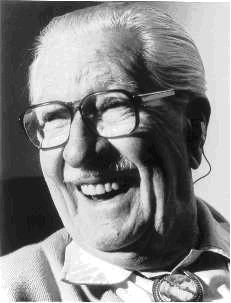It’s Christmas: long live Carl Barks
*special contribution from friend Arlei Rockenbach
Did you know that the creator of Uncle Scrooge was deaf? And who used to parade around with his hearing aid on? Not me. That’s why I was honored when a friend (a listener) sent me this special Christmas collaboration for Crônicas.
“For 365 or 366 days a year, we live in the present, trying to make the best use of the time we have been given. Most of what we live through will be forgotten, totally or partially – and some moments, some days, by the miracle of memory will last for our entire eternity. For me, that’s how it is with the thirty-odd Christmases I’ve experienced so far.
Some of them are more detailed, others only have a few visual lapses, but I think I can remember them all – it’s the only day that’s automatically saved on my mind’s hard drive (birthdays, for example, don’t give the same guarantee). And in most of the saved Christmases of my childhood, the work of Carl Barks lives on.
Carl Barks was a typical American country bumpkin, born in rural Oregon, who had very little access to formal or informal education. He never had great social skills (most of the time he was a semi-urban hermit), had a very tumultuous family life, was severely hearing impaired and didn’t earn a fortune from his work. But it was this same work that led to his immortality, an unsuspected and original immortality in a genre of marginal and very underrated literature: Carl Barks is, if not the greatest, one of the greatest comic book authors and designers of all time.
Carl Barks is so important in the field that he is called “Il Maestro” by almost every researcher in the world, and is considered hors-concours in any election of great comic geniuses. And he wasn’t the author of adventure comic strips, mythical or iconic heroes like Tarzan or Flash Gordon, or counter-culture comics like those by Robert Crumb, or superheroes like those by Marvel. No, Carl Barks drew practically a single, naive and trivial style of character throughout his life: Disney’s talking ducks.
Barks began his career in Disney studies with minor works, but the first to give him some prominence was Donald Duck, a character who already existed in the Disney universe, but was much less important. Barks ended up building the entire personality, family, town and legend of Disney’s Duck Family. Barks was responsible for both the script and the art of the stories themselves, and in both fields he proved to be a genius: his strokes are very beautiful, elegant, complex and detailed – unlike the more simplistic style of artists who drew Mickey, for example. That alone would make Barks’ stories a landmark, but what really elevated him to the status of a holy monster were his scripts, full of subtleties and twists while still being funny. Barks also perfected the technique of adding subtleties to the story using only graphic resources (the so-called visual gags, in the style of Chaplin’s silent films). The very way of telling comic stories changed with Barks: his characters had more refined elements of personality, they went on adventures full of cultural references and unusual outcomes. The culmination of Barks’ work is the most famous character he created, Uncle Scrooge.
Uncle Scrooge’s original name is Uncle Scrooge – and it’s a reference to the character Ebenezer Scrooge from the famous book “A Christmas Carol” by Charles Dickens, in which a stingy old man is visited on Christmas Eve by the spirits of Christmas Past, Christmas Present and Christmas Future, a classic story from universal literature. Uncle Scrooge was created just for a Christmas story, with the same basic characteristics as Dickens’ Scrooge: old, grumpy, rich and miserly – but, deep down, with a good heart. The character was so popular that he created a life of his own, stories of his own and, over time, the habit of going on fabulous adventures that only a millionaire could enjoy, such as traveling the world in search of the Philosopher’s Stone or discovering Atlantis by probing the ocean for a lost coin.
I loved Carl Barks without knowing him: I liked the Disney Christmas specials published by Editora Abril, where most of the stories were those whose lines I could identify straight away: I didn’t know the author, but I knew that those stories with firmer lines and more detailed scenes were the best and most delightful to read. When I was thirteen or fourteen, I discovered the identity of the author of those gems (Barks was still alive at the time), and the more I found out about him, the more I became a fan of his art and his originality.
Barks used to make fun of himself, occasionally drawing himself among the ducks. He almost always portrayed himself as a skinny, big-nosed old man with a hearing aid, which he had to wear since early adulthood and which he was never shy about wearing – in one of his stories, even Donald Duck is forced to wear one.
I’ve got a good number of Carl Barks stories at home, which I’ve often reinforced by rummaging through thrift stores. As well as being (and this is recognized all over the world) true works of art, they remind me so poignantly of my childhood (and Christmas in particular) that they are priceless pieces. I have a bit of Cervantes, Homer, Darwin, Veríssimo… and Carl Barks. I don’t place him lower on my bookshelf than other great writers of humanity.
Charles Dickens, author of the original “A Christmas Carol”, became so associated with Christmas that, when he died, a poor girl exclaimed “Is Dickens dead? And Santa Claus, is he dead too?”. He didn’t die, and Carl Barks (who died in 2000) helped perpetuate his Christmas icons in the figure of Uncle Scrooge, who may survive for as long or longer as Ebenezer Scrooge or even Santa Claus.
Because he was part of my childhood and is now part of my bookshelf, Carl Barks is one of those good old friends who should stay with me for life… so I have to say: Merry Christmas, Carl Barks!”
May I take this opportunity to wish you a HAPPY CHRISTMAS to all of you – and to thank you for being here, for your affection, for your company, for the stories we’ve shared this year.
If you want to check out Arlei Rockenbach‘s writings, his website is http://polifonias.wordpress.com! And to Arlei, thank you so much for this enriching post full of history and culture!






